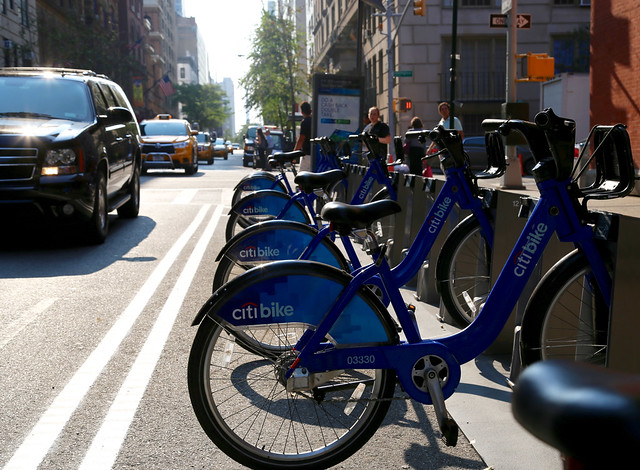
(photo: New York City Department of Transportation)
New Yorkers across the city have reason to celebrate, with the news that the Citi Bike network is expanding to the Bronx and deeper into Brooklyn and Queens -- bringing the benefits of bike share to every corner of Manhattan and extending its reach into neighborhoods like Morrisania, Flatbush, and Jackson Heights.
Citi Bike’s expansion into more communities of color not only represents a huge opportunity for improving New Yorkers’ lives; it will help set the tone for cities across the country and the world.
It’s important that we get this right, scaling Citi Bike’s existing equity programs alongside this massive infrastructural investment.
Through my work with the Bedford Stuyvesant Restoration Corporation, the nation’s first community development corporation (CDC) focused on promoting the economic futures of black families in Central Brooklyn, I’ve been on the front lines of encouraging ridership and promoting a feeling of system ownership among black and Latinx residents.
We’ve hosted bike rides, worked with the city Department of Transportation to give away helmets, promoted low-cost memberships, and cultivated community champions; with our seat at the table, we have pushed for policies to benefit communities of color, like changing pricing for SNAP recipients and ensuring that youth have access to Citi Bike.
We adapted as we learned, and we’ve had real results. Ridership in Bed Stuy is growing faster than systemwide since we signed on as a Citi Bike partner. One year ago, we joined Citi Bike and Healthfirst in launching Reduced Fare Bike Share. More than 3,400 low-income New Yorkers have signed up for Citi Bike for only $5 a month.
Here’s what we’ve learned -- I hope it provides guidance in Citi Bike’s new phase of expansion:
First, community engagement must be real and consistent.
There are complex reasons that ridership is lower in majority-minority neighborhoods than others, at least in part due to the suspicion that the system isn’t meant for everyone.
As Restoration’s partnership with Citi Bike has proven, real impact comes with grassroots organizing and consistent community presence. Citi Bike and Healthfirst’s newly-announced $300,000 Community Grant Program for local nonprofits in the expansion zone will go a long way; there must be a sustained commitment to these partnerships long after that seed money has run out.
Second, there must be parallel investments in protected bike lanes.
Expanding Citi Bike is a great first step, but equal commitment to protected bike lanes in these new neighborhoods is crucial to encouraging ridership from a diverse array of residents.
Studies have shown that female ridership, for example, is boosted by a feeling of security on a bike, and that bike safety is achieved in numbers.
Bike safety is a compounding phenomenon: the more comprehensive the infrastructure is, the more people will ride; the more people ride, the safer the roads become.
Third, the fight for transit equity does not stand alone.
We must remember that advocacy around transportation equity is part of a larger effort to stem the tide of historic disinvestment across many facets of life in communities of color.
The City and its partner Citi Bike have an opportunity to model what equitable infrastructure investment looks like; not just what resources are where and when, but who is at the table when those decisions are made.
We must be aware of the unintended consequences of our decisions, and ensure that our investment in communities doesn’t equal the displacement of longtime residents.
As Citi Bike expands, I’ve already seen a real effort to address these challenges, to scale what’s working and to correct what isn’t.
Expansion of collaborative efforts like the Better Bike Share Partnership, authentic community engagement and support, and affordable pricing will help guarantee that equity goals are met. They will undergird all efforts to ensure that bike adoption in new neighborhoods is top-of-mind and that infrastructure investment is responsible.
It wasn’t long ago that many in communities like Bed Stuy bemoaned Citi Bike’s arrival. Just a few years later, New Yorkers stood on the steps of City Hall to demand bikeshare quicker and that it reach further.
It was one of the quickest changes in public approval maybe ever, and speaks to the system’s overwhelming success in not only getting people where they need to go, but doing it in a way that people enjoy.
I believe we’re close to realizing a system that meaningfully supplants car ownership and is cemented as part of the public transit infrastructure across the boroughs.
With a thought-out, comprehensive plan for bike equity, Citi Bike can meaningfully support communities across the city, bringing new access to former transit deserts, opening up economic opportunity for diverse commercial hubs, making our communities greener and healthier, and showcasing to the world what a truly equitable, integrated transportation system can look like.
***
Tracey Capers is Executive Vice President of Stuyvesant Restoration Corporation.
***
Have an op-ed idea or submission for Gotham Gazette? Email This email address is being protected from spambots. You need JavaScript enabled to view it.




